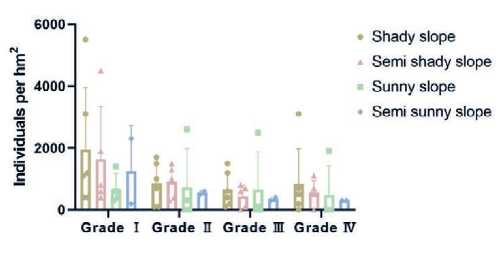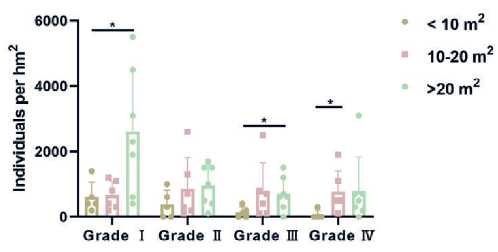The results showed that the regeneration density of cypress was mainly affected by soil stone content and forest gap area. Adjusting the determination coefficient R2 to 0.739 showed that these two variables could determine the regeneration density of cypress to a higher extent. Taken together, soil stone content, slope direction, and forest gap area were important environmental factors for promoting cypress regeneration.
|
Table 7. Multiple regression model between cypress regeneration density and environmental factors Tablica 7. Model višestruke regresije između gustoće prirodnog pomlatka obične azijske tuje i ekoloških čimbenika |
| B | b | t | P | |
|
Constant term |
-2030.644 |
-2.642 |
0.012 | |
|
Soil stone content |
295.61 |
0.621 |
5.459 |
0 |
|
Gap area |
223.517 |
0.307 |
2.697 |
0.01 |
Subsequently, to further explore the effects of soil stone content, slope direction, and forest gap area on cypress regeneration, we respectively analyzed the correlation between their and the number of cypress seedlings. As shown in Table 7, the number of cypress regeneration seedlings showed an upward trend with the increase of soil stone content. The soil of the sample plot contains a lot of gravel, and the gravel is evenly distributed in the soil (Table 7).
|
Table 8. Number of cypress regeneration seedlings in different soil stone content Tablica 8. Broj prirodnog pomlatka obične azijske tuje u tlu različite kamenitosti |
| Soil stone content Kamenito tlo |
Grade I Klasa I |
Grade II Klasa II |
Grade III Klasa III |
Grade IV Klasa IV |
Renewal density individuals / hm2 Gustoća obnavljanjapojedinačno / hm2 |
|
> 50% |
146 |
128 |
109 |
103 |
48600 |
|
30% - 50% |
31 |
17 |
12 |
7 |
6700 |
|
10% - 30% |
10 |
6 |
2 |
2 |
2000 |
|
< 10% |
11 |
7 |
5 |
6 |
2900 |
We also analyzed the effect of slope direction on cypress regeneration seedlings in 18 sample plots with cypress regeneration (Figure 6). The regeneration capacity of regenerated cypress seedlings with different slope directions was ranked as follows: shady slope > semi shady slope > sunny slope > semi sunny slope. There was no significant difference in the number of grade I seedlings on the four slopes, but significantly different between the grade II seedlings on the shady slope and the sunny and semi sunny slope were observed. The number of grade Ш seedlings on shady slope was significantly different from the other three slope directions. The difference results of the grade IV seedlings were the same as those of the grade II seedlings (Figure 6).

|
Figure 6. Number of renewal seedlings in different slope directions. Slika 6. Broj sadnica iz prirodne obnove na različitim ekspozicijama. |
In addition, the number of grade I seedlings in forest gap of > 20 m2 and number of grade IV seedlings in forest gap of < 10 m2 were respectively significantly different from that in other levels of forest gap. We also found that the number of regeneration seedlings was the highest in the group of gap area > 20 m2 in all four height Grade (Figure 7), which was consistent with our previous results that the larger gap area was favorable for cypress regeneration.

|
Figure 7. Number of regeneration seedlings in different gap areas. *
represents P < 0.05. Slika 7. Broj sadnica iz prirodne obnove u različitim površinama otvora. * predstavlja P < 0,05. |
Discussion
Rasprava
NR of cypress plantations is considered challenging, and evaluating the regeneration potential of cypress plantations is of great significance for scaling up the natural
